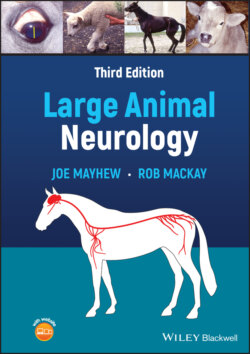Читать книгу Large Animal Neurology - Joe Mayhew - Страница 65
Magnetic resonance imaging
ОглавлениеUndoubtedly, magnetic resonance (MR) imaging with and without gadolinium contrast is superior for identifying lesions primarily involving nervous tissues, and studies of the normal variability of brain and spinal cord MR morphology of large animals are available.164–166 Identifying pathologic changes has assisted in diagnosing a wide range of diseases, including brain abscess, brain injury, pituitary adenoma, nigropallidal encephalomalacia, otitis media, hydrocephalus, cerebellar disorders, aplasia of corpus callosum, inflammatory foci, and coenurosis.144,150, 151,164–173 An example of the clinical application of MR imaging to equine brain disorders is given in Figure 3.17.
In making judgements from any test procedure such as cervical radiographs, it is axiomatic that, depending on cutoff criteria taken from reference values, there will be variable proportions of false‐positive and false‐negative diagnoses. As well as considering normal variance, test error, and clinician bias, any test is only a snapshot in time so that results may well have changed since the onset of the problem.
Figure 3.16 CT myelograms of an 18‐month‐old ataxic Thoroughbred horse that underwent ventral stabilization surgery at C6‐7 for Type‐II CVM. A, B & C are cranial views (left is to the right side) of transverse plane images at C5‐6, C3‐4, and C6‐7, respectively. The stainless‐steel basket implant can be seen ventrally in C. In A, there are prominent osteophytes on the dorsal margins of the APJs and the left intervertebral foramen at that site is markedly narrow with adjacent sclerotic changes suggesting contact across the foramen (orange circle). In B there is marked, asymmetric osteochondral modeling of APJs that is much worse on the left, narrowing of the joint spaces bilaterally, a region of osteolysis (arrow) and patchy areas of bony attenuation in the left C6 articular process. There is extensive modeling of both sets of APJs and joint spaces and intervertebral foramina are markedly narrow at C6‐7 in C, although as in B, such narrowing seen on one slice does not constitute reason to diagnose foraminal stenosis with intervertebral neurovascular bundle compression. Spinal cord compression is not evident in any of these views.
Figure 3.17 Brain 3T MR images of a horse with presumptive equine protozoal myeloencephalitis {EPM]. Rostral is to the left in panel C and towards the top of panel D; the left side of the brain is to the right of images A, B & D. The images in A, B & C are T2‐weighted sequences and D is a short‐T1 inversion recovery (STIR) sequence. The transverse images A & B were obtained at the planes indicated by a & b in C. Image C is a sagittal section at plane c in A. D is a ventral view of a dorsal plane just ventral to the mesencephalic aqueduct.This 15‐year‐old Holstein hunter gelding had a 2‐week history of somnolence, right‐sided central blindness, and predominantly right‐sided limb ataxia and weakness. snSAG serum:CSF ratio was 6 (values <100 consistent with EPM). The horse was given nonstandard 7x doses of ponazuril on 2 successive days. The day before presentation, he suddenly developed mild right‐sided head tilt and facial paresis. There are at least 3 areas of increased signal intensity in the basilar regions: (i) left midbrain extending from the junction with the pons well into the diencephalon (thalamus/hypothalamus; white arrows); (ii) right midbrain (yellow arrows); and (iii) left rostral thalamus (blue arrows). These areas did not enhance with gadolinium. The visible lesions may account for the blind right eye (left thalamus), for persistent somnolence (sleep centers in the reticular formations of the midbrain and thalamus) and forelimb weakness and conscious proprioceptive deficits but spinal/cerebellar ataxia, facial paresis and head tilt may have resulted from additional un‐sectioned medullary, cerebellar or spinal cord foci. Unfortunately, the horse was unable to regain its feet after the MRI procedure and was euthanized. Histopathologic examination revealed moderate to severe lymphoplasmacytic and histiocytic encephalitis of the midbrain and thalamus, with multifocal neuronal degeneration and gliosis. Protozoal stages were not seen, possibly because of previous antiprotozoal treatment. The authors have successfully treated several other horses with similar MR lesions consistent with EPM.
